Introduction
In the rapidly evolving landscape of software development, Continuous Integration (CI) and Continuous Delivery (CD) have emerged as essential methodologies that empower organizations to enhance their operational efficiency and responsiveness. By streamlining code integration and automating deployment processes, CI/CD practices facilitate quicker releases and foster a collaborative culture among development teams.
As companies grapple with the challenges of integration complexity and cultural resistance, understanding the foundational principles of CI/CD becomes imperative. This article delves into the significance of CI/CD, explores key tools that automate these processes, and outlines best practices for effective implementation.
Furthermore, it addresses the common hurdles organizations face in their journey towards automation, emphasizing the critical role of automated testing in achieving sustained success. Through insights and real-world examples, this discourse aims to equip professionals with the knowledge necessary to navigate the complexities of modern software delivery.
Understanding CI/CD: Foundations and Importance
Continuous Integration (CI) and Continuous Deployment (CD) represent crucial practices that allow developers to implement code changes with increased frequency and reliability. CI entails the routine merging of developers' working copies into a shared mainline multiple times throughout the day, facilitating the early identification of integration issues. Building on this foundation, automating CI/CD enhances the release process, ensuring that new features and fixes are deployed consistently and swiftly.
This dual approach not only speeds up the software delivery pipeline but also fosters a culture of collaboration and quality assurance among groups. As articulated by Cody Slingerland:
DevOps specialists work across departments and teams
This reinforces the interconnectedness essential for success. However, it is important to acknowledge that 45% of DevOps leaders face cultural resistance as a major obstacle to the successful adoption of continuous integration and continuous delivery methods.
Furthermore, a report from the DevOps Research and Assessment (DORA) reveals that organizations adopting continuous integration and continuous delivery practices achieve:
- 200 times more frequent deployments
- Experience recovery from failures 24 times faster
A real-world example of the effectiveness of continuous integration and continuous delivery can be seen in the case of CloudZero, which offers a comprehensive solution for managing cloud costs. Firms such as Drift have saved $2.4 million each year on AWS expenses by leveraging CloudZero's services, showcasing the operational efficiencies achieved through continuous integration and delivery methodologies.
These statistics highlight the significant operational efficiencies and improved customer satisfaction achieved through automating CI/CD practices.
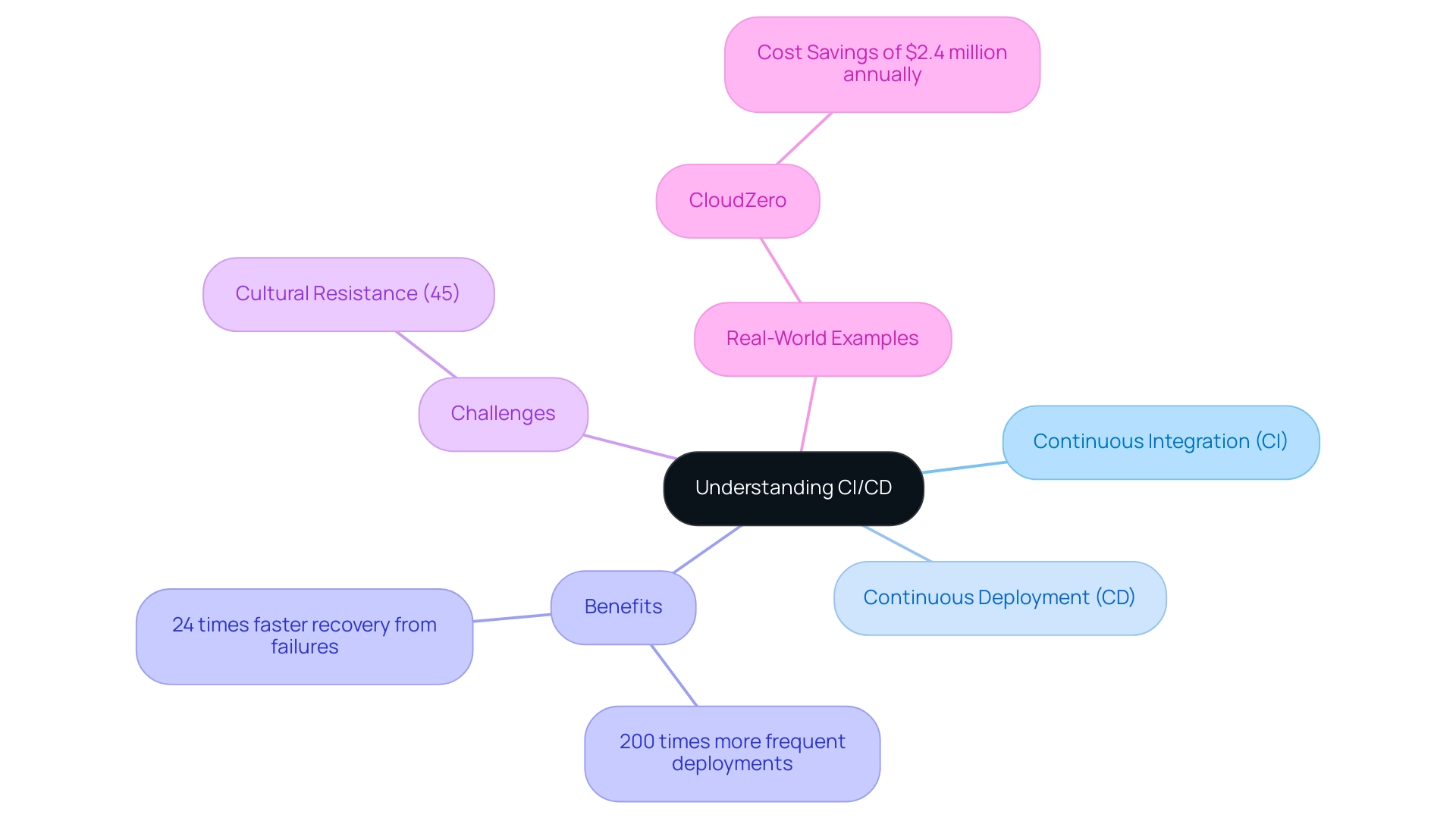
Key Tools for Automating CI/CD Processes
A variety of powerful tools is available for automating ci/cd processes, each designed with unique features to cater to diverse environments. Jenkins, an open-source automation server, stands out for its extensive plugin ecosystem, allowing for high levels of customization in building, deploying, and automating software development workflows. According to recent statistics, Jenkins continues to be a dominant player in the market, with a significant share among software development groups.
The continuous integration and continuous delivery tools market size is projected to reach multimillion USD by 2029, underscoring the growing importance of these tools in the industry. Meanwhile, CircleCI offers a robust cloud-based solution that integrates seamlessly with GitHub and Bitbucket, providing developers with an intuitive interface and advanced analytics to enhance productivity. Additionally, GitLab CI has gained popularity for its direct integration with Git repositories, facilitating automated builds and tests without requiring teams to switch contexts.
As one expert noted, 'I also liked matrix builds that I used to test my code concurrently across multiple systems and cut down the time I spent on repetitive evaluations.' By carefully choosing tools that align with specific project requirements, organizations can effectively enhance operational efficiency by automating ci/cd in their continuous integration and delivery pipelines. The necessity for such advancements is emphasized by reports showing that many organizations are underperforming even after adopting DevOps methodologies, underscoring the essential role that automating ci/cd has in enhancing performance.
Additionally, tools such as Docker demonstrate the advantages of these advancements; Docker allows developers to create, deploy, and manage applications within lightweight, portable containers, ensuring uniform configurations across environments and integrating seamlessly with existing continuous integration and delivery tools.
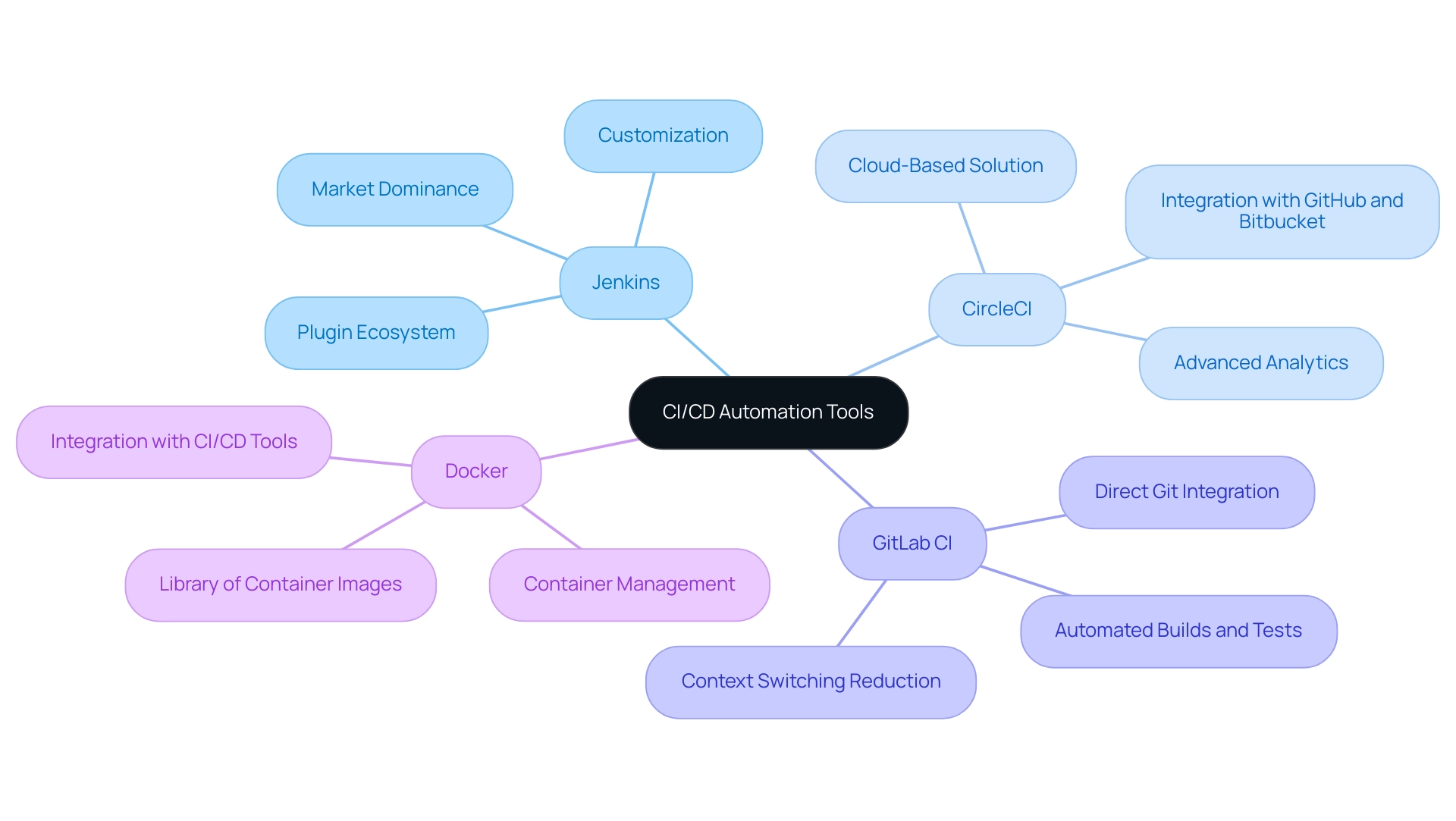
Best Practices for Effective CI/CD Automation
To effectively implement automating CI/CD, organizations must prioritize several best practices that align with current trends and address existing challenges. First, adopting a microservices architecture, where feasible, is crucial. This approach enables teams to develop, test, and deploy services independently, thereby reducing interdependencies and streamlining workflows.
- Automated testing should be integrated at all stages of the pipeline to ensure code quality and minimize defects, which is essential in a landscape where 29% of DevOps leaders cite legacy systems as a significant problem.
- Furthermore, increasing automation not only minimizes errors but also optimizes resource use, which is vital for maintaining efficiency.
- Maintaining a robust version control system, such as Git, facilitates effective change tracking and release management.
Continuous monitoring, coupled with feedback loops, is vital for identifying issues proactively and adapting processes accordingly. Using tools like Grafana and Prometheus can greatly improve monitoring abilities, as evidenced by successful case studies concentrating on the optimization of development and deployment pipelines, which have shown notable enhancements in pipeline efficiency and performance metrics. Significantly, 6.8% of firms utilizing DevOps are based in India, indicating a rising global trend in embracing these methods.
Ultimately, promoting a culture of teamwork and collective accountability among team members is essential to guarantee that everyone is committed to the success of automating CI/CD processes. By embracing these best practices, organizations can enhance software delivery efficiency, reduce operational risks, and ultimately improve customer satisfaction.
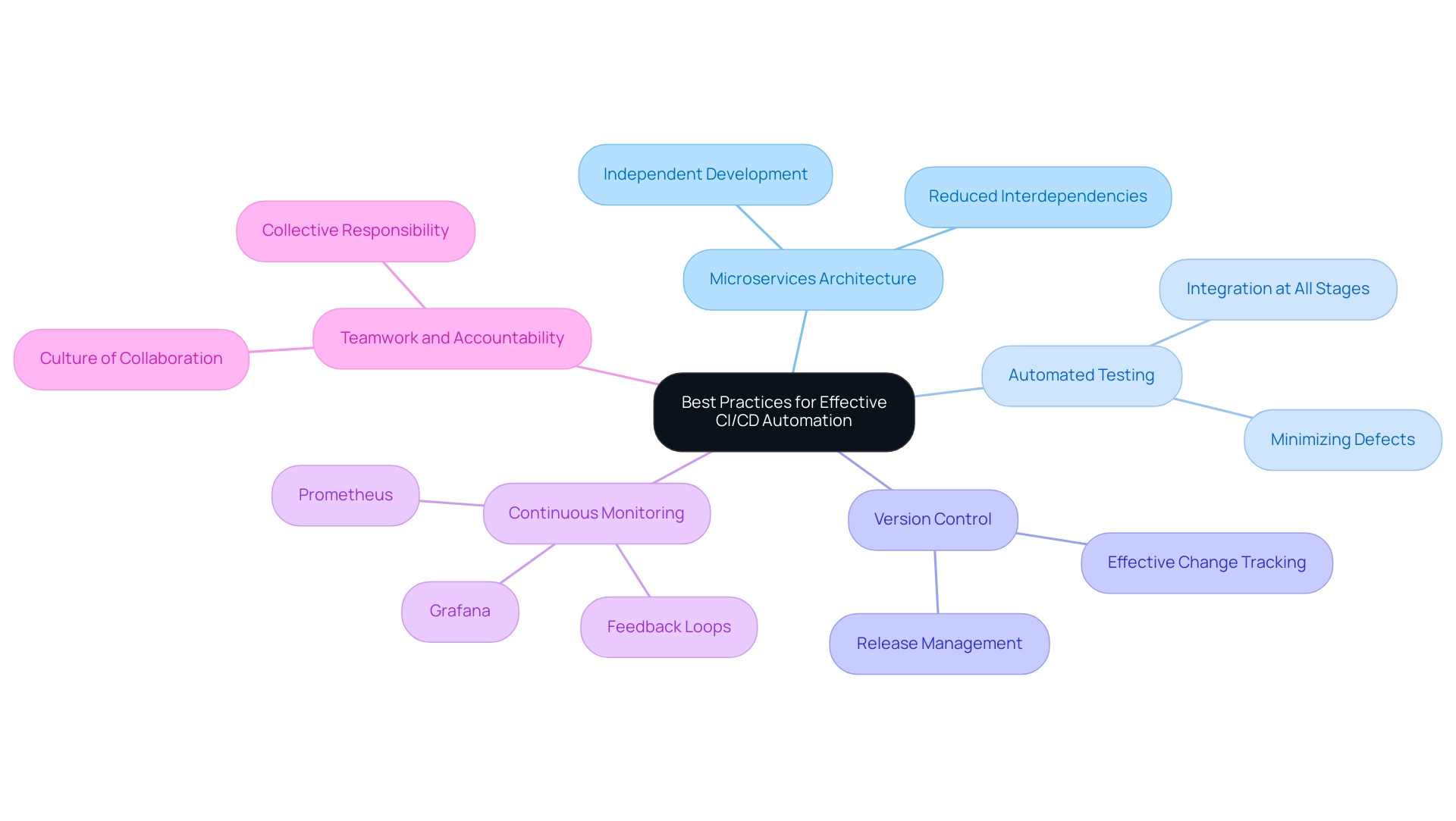
Overcoming Challenges in CI/CD Automation
While automating CI/CD offers numerous benefits, organizations frequently encounter challenges such as integration complexity, resistance to change, and inadequate testing coverage. To effectively address integration complexity, it is essential to ensure that your continuous integration and delivery tools are compatible with existing systems and that comprehensive documentation is provided for group members. This approach not only eases the integration process but also empowers teams to navigate complexities with confidence.
Tackling opposition to change is just as crucial; promoting robust leadership backing and conveying the concrete advantages of continuous integration and continuous delivery methods to all stakeholders can greatly lessen resistance. For instance, as noted by Martin Schneider, Delivery Manager:
Before BrowserStack, it took eight test engineers a whole day to test. Now it takes an hour.
We can release daily if we wanted to. This illustrates how automating CI/CD can streamline processes and enhance productivity. Additionally, security vulnerabilities in the continuous integration and continuous delivery pipeline present significant challenges, as highlighted in a recent case study.
Implementing effective monitoring systems and limiting sensitive information can help detect threats and secure the pipeline. Furthermore, organizations like Drift have demonstrated the financial benefits of effective CI/CD practices, saving $2.4 million annually on AWS costs. It’s also important to recognize that most DevOps teams utilize multiple tools simultaneously to address different stages of the DevOps lifecycle.
To further enhance examination coverage, adopting a test-driven development (TDD) approach is advised, alongside regular reviews of test cases to ensure alignment with current requirements. Proactively tackling these challenges can lead to more effective automating CI/CD processes, ultimately fostering greater success and innovation within the organization.
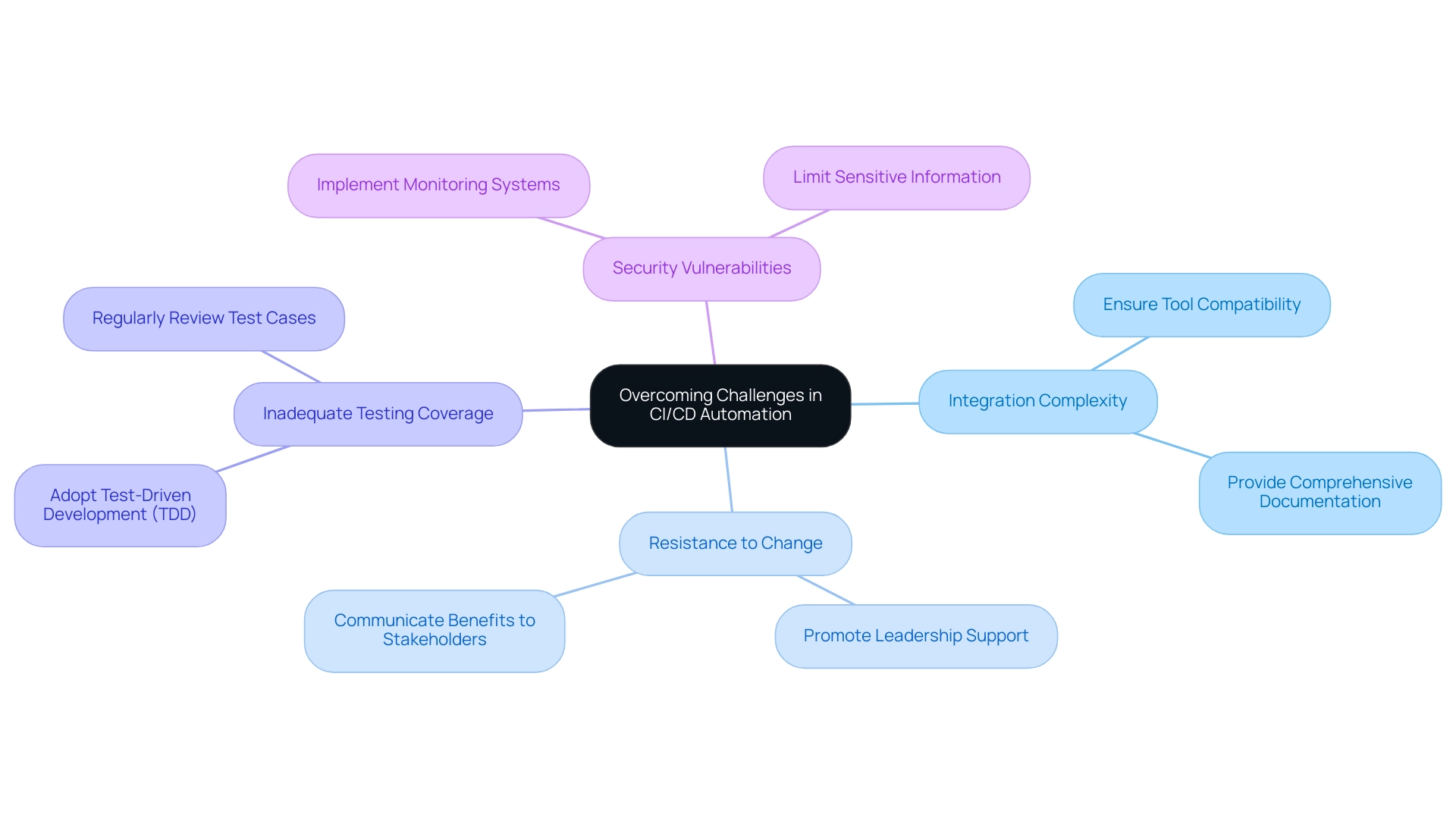
The Role of Automated Testing in CI/CD Success
Automating CI/CD is essential for the success of Continuous Integration and Continuous Delivery practices, as it provides quick feedback on code changes and ensures that quality remains intact throughout the development lifecycle. To achieve comprehensive coverage, it is crucial to implement various evaluation methods, including:
- Unit tests
- Integration assessments
- End-to-end checks
Tools such as Selenium and JUnit serve as pivotal components within the CI/CD pipeline, automating these essential evaluation processes and streamlining workflows.
Moreover, the adoption of a shift-left evaluation approach—where assessment is integrated earlier in the development cycle—proves to be highly effective. This strategy allows teams to identify and address issues at an early stage, ultimately reducing the overall costs and time associated with bug fixes. According to industry insights, 60% of organizations employing test automation report substantial enhancements in application quality, further emphasizing the significance of automating CI/CD within Continuous Integration and Continuous Delivery frameworks.
Katalon highlights the importance of this transformation, stating that "90% of companies concur or strongly concur that investing in transformation is essential for facilitating continuous delivery." This emphasizes the increasing acknowledgment of the importance of automating CI/CD in attaining continuous integration and deployment success. As we approach 2024, the role of automating CI/CD will only grow in importance through automated evaluation, with predictions suggesting that software testers could see productivity gains of up to 15% by leveraging generative AI technologies.
Furthermore, the swift expansion of the codeless evaluation market, anticipated to hit approximately 6.5% in 2023, mirrors current trends in automated tools, making it crucial for organizations to remain informed about these developments. Furthermore, real-world challenges such as those presented in the Mobile and IoT Testing case study illustrate the necessity of automation in ensuring the reliability and security of IoT devices. By prioritizing automated testing, organizations not only enhance the reliability and quality of their software products but also position themselves for sustained success in an increasingly competitive landscape.
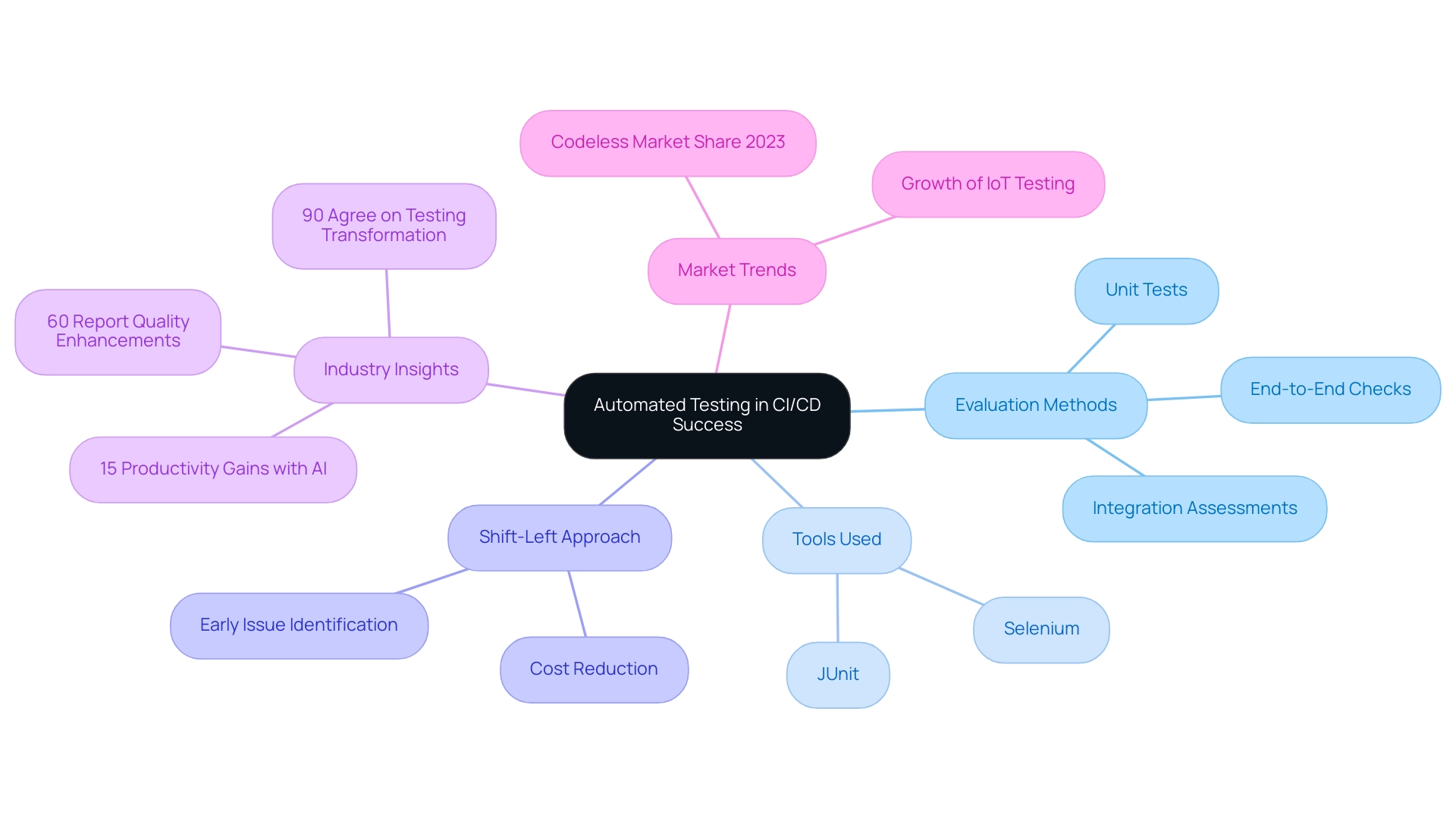
Conclusion
Implementing Continuous Integration (CI) and Continuous Delivery (CD) practices is no longer just an option but a necessity for organizations aiming to thrive in today's fast-paced software development environment. The foundational principles of CI/CD, which emphasize frequent code integration and automated deployment, are crucial for enhancing operational efficiency and fostering a culture of collaboration among development teams. By understanding the significance of these methodologies and leveraging key tools such as Jenkins, CircleCI, and GitLab CI, organizations can streamline their workflows and significantly improve their deployment frequency and reliability.
Moreover, adhering to best practices in CI/CD automation, such as adopting microservices architecture and prioritizing automated testing, is essential for overcoming common challenges and ensuring high-quality software delivery. As highlighted, the role of automated testing cannot be overstated; it is integral in maintaining code quality and enabling rapid feedback throughout the development lifecycle. The proactive approach to integration complexities and resistance to change further reinforces the need for effective leadership and communication within teams.
In conclusion, the journey toward successful CI/CD implementation is fraught with challenges, yet the benefits—ranging from increased deployment frequency to improved customer satisfaction—are profound. Organizations that prioritize CI/CD, embrace automation, and invest in testing will not only enhance their operational capabilities but also secure a competitive edge in the ever-evolving landscape of software development. The time to act is now; embracing these practices will pave the way for sustained innovation and success in the future.




